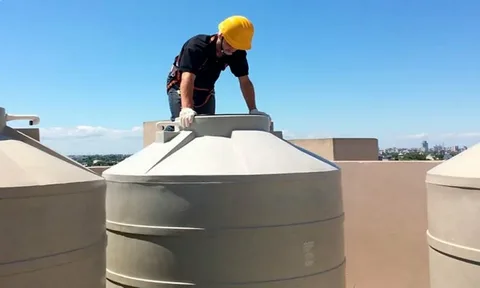From Cleaning to Disinfection: How We Ensure Water Safety in Every Tank

Water is the ultimate resource for human life. Still, the cleanliness of the water we drink always lies in how clean and healthy our storage containers are—most notably, water tanks. At home, at work, or in industries, these tanks contain the water we drink, cook, clean with, and carry out other crucial daily activities. With time, sediment, algae, bacteria, and other pollutants can settle inside water tanks and contaminate the water, posing a threat to our well-being. Therefore, a thorough process, from cleaning to disinfection, is essential in ensuring water safety.
Here, we'll guide you through ensuring that all the tanks we work on give clean, safe, and healthy water. You're either a homeowner or a facilities manager; you'll have confidence in your water tank being clean and safe.
Knowing the Importance of Clean Water Tanks
Water tanks, particularly rooftop or underground tanks, tend to be neglected until something goes wrong. Regular maintenance is essential, though, since stagnated water in tanks is a breeding ground for dangerous bacteria like E. coli and Legionella. Debris, insects, and even animal dung may taint stored water if tanks are not well-sealed and maintained.
This is why the term "Water tank cleaning service" is not merely a general service but an essential measure of health and hygiene. Providing water safety requires more than cleaning away dirt—it is a multi-step process targeting all possible contaminants.
Pre-Cleaning Inspection and Assessment
Our process starts with a thorough inspection of the tank. This involves examining:
The tank's type and size
Evidence of algae or biofilm growth
Presence of sediment and debris
Structural defects like cracks or leaks
Insect or rodent entry points
This evaluation allows us to identify the extent of contamination and the cleaning and disinfection techniques needed. We also consider the tank material (plastic, concrete, steel, etc.) to select appropriate cleaning agents and equipment.
Draining the Tank
After the preliminary check, we safely drained all the tank water. Draining is necessary to gain access to the tank interior and avoid mixing dirty water with a clean supply.
We employ pumps or gravity drainage systems depending on where the tank is placed and how the plumbing system is designed. All the wastewater is disposed of according to environmental standards to ensure no adverse effect on the surroundings.
Sludge and Manual Cleaning
This is where our Water tank cleaning service truly begins to pay off. Our skilled technicians enter the tank (when size allows) with proper safety equipment or utilize specialized equipment for smaller tanks. We scrub the interior floor and walls of the tank by hand to eliminate the following:
Sediment and sludge
Algae and moss growth
Rust stains and scaling
Employing high-pressure water jets and mechanical scrubbers provides a thorough clean that manual processes cannot provide.
Vacuuming and Sludge Disposal
The loosened dirt, algae, and other residues are vacuumed after scrubbing. High-powered wet vacuum machines ensure that not even a tiny particle is left behind in the tank. The collected waste is sealed and disposed of in an environmentally friendly manner, per local environmental regulations.
This step leaves the tank clean but not as yet safe to use. Safety happens next: disinfection.
Process of Disinfection
The disinfection step is a part of our maintenance process in this water tank. Cleaning the tank only takes care of the stuff we can see, and disinfecting kills what you can't see, like viruses, bacteria, and fungi. We use safe, non-toxic, and food-grade disinfectants that are safe for consumption upon rinsing off the tank and refilling.
These are the most critical steps in our disinfection procedure:
Fogging or spraying disinfectant within the tank
Holding time for the disinfectant to dwell for a particular time
Rinsing exhaustively until all chemical traces are gone
We also apply UV sterilization or chlorine dosing (depending on the type of tank and client preference) for total germ removal.
Last Rinse and Refilling
Following disinfection, we provide the tank with the final rinse with high-pressure clean water to eliminate every remaining disinfectant. Next, the tank is filled with water, and water testing (on request) is performed to certify that the water is safe. The final step is a post-service check to ensure no leak, odor, or water pressure issue.
Preventive Measures and Recommendations
Our service doesn't stop with cleaning. We provide a quick consultation with customers to assist them in better care for their tanks in between professional cleaning. Some of the suggestions we have are:
Using insect-proof lids
Sealing all the tank entry points
Installing overflow filters
Booking tank inspections every 6-12 months
We also offer reminder services for your next clean so you don't miss out on another maintenance cycle.
Why Choose Our Water Tanks Cleaning Service?
Selecting our water tank cleaning service means choosing a professional, safe, and detailed cleaning process. Our staff uses only certified equipment and environmentally friendly cleaning chemicals. We meet all health and safety regulations and minimize disruption during the service.
Residents of residential societies, hotels, schools, hospitals, and commercial complexes trust us because we don't merely clean tanks—we guarantee water safety. Customer-centricity and decades of experience establish us as a trusted tank cleaning and disinfecting partner.
Conclusion
Making water safe isn't merely about tank cleaning—it's about adhering to a thorough, step-by-step process that removes all potential contaminants. From inspection to deep cleaning, disinfection, and safety guidance, our Water tanks cleaning service guarantees that your stored water is safe, pure, and ready for use.
Copyright © 2019 Zenith Crew. All Rights Reserved .
Designed by Hub Sol